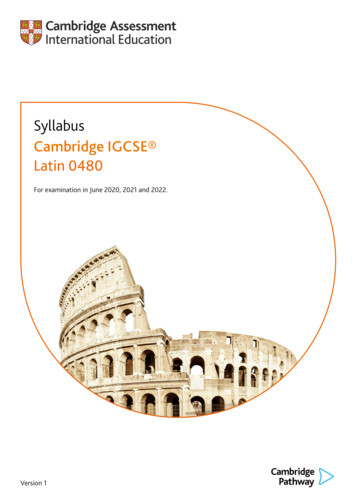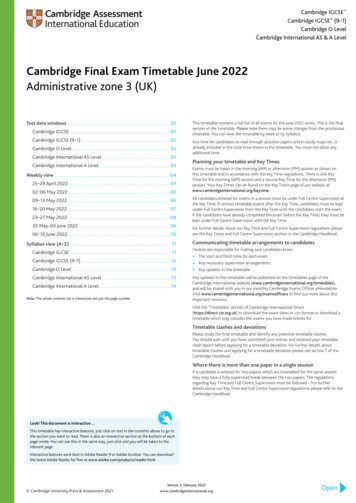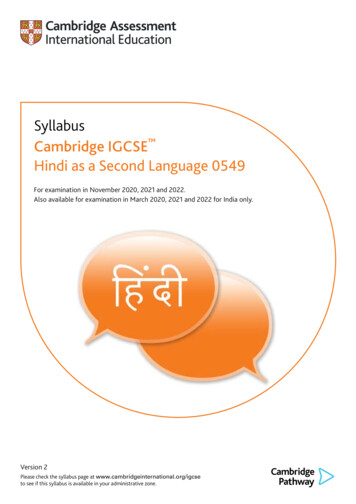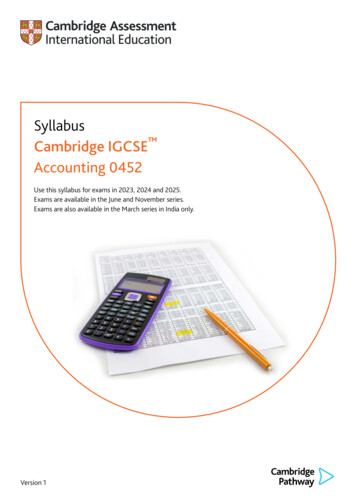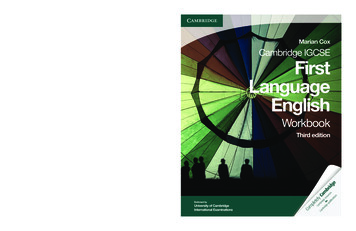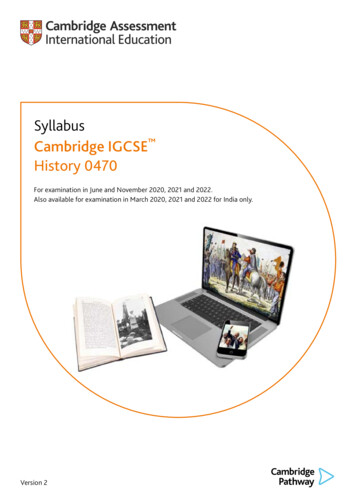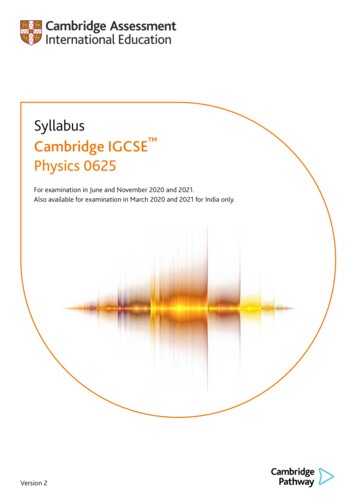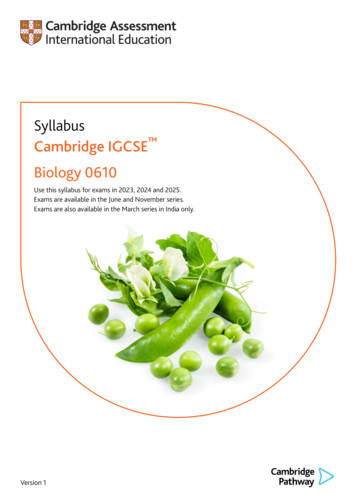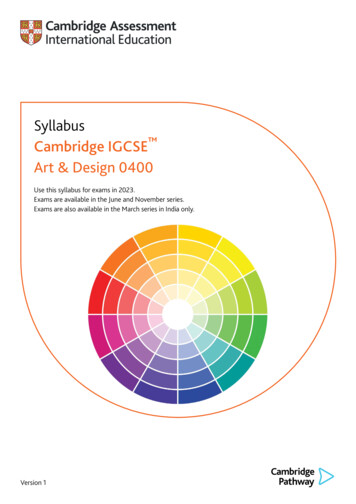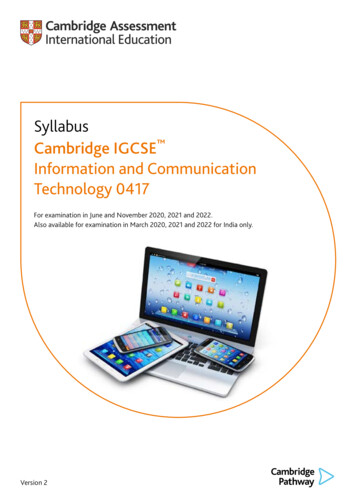
Transcription
Syllabus Cambridge IGCSEInformation and CommunicationTechnology 0417For examination in June and November 2020, 2021 and 2022.Also available for examination in March 2020, 2021 and 2022 for India only.Version 2
Why choose Cambridge?Cambridge Assessment International Education prepares school students for life, helping them develop an informedcuriosity and a lasting passion for learning. We are part of the University of Cambridge.Our international qualifications are recognised by the world’s best universities and employers, giving students awide range of options in their education and career. As a not-for-profit organisation, we devote our resources todelivering high-quality educational programmes that can unlock learners’ potential.Our programmes and qualifications set the global standard for international education. They are created by subjectexperts, rooted in academic rigour and reflect the latest educational research. They provide a strong platform forlearners to progress from one stage to the next, and are well supported by teaching and learning resources.Our mission is to provide educational benefit through provision of international programmes and qualifications forschool education and to be the world leader in this field. Together with schools, we develop Cambridge learnerswho are confident, responsible, reflective, innovative and engaged – equipped for success in the modern world.Every year, nearly a million Cambridge students from 10 000 schools in 160 countries prepare for their future withan international education from Cambridge International.‘We think the Cambridge curriculum is superb preparation for university.’Christoph Guttentag, Dean of Undergraduate Admissions, Duke University, USAQuality managementOur systems for managing the provision of international qualifications and education programmesfor students aged 5 to 19 are certified as meeting the internationally recognised standard forquality management, ISO 9001:2008. Learn more at www.cambridgeinternational.org/ISO9001Cambridge Assessment International Education is part of the Cambridge Assessment Group. Cambridge Assessment is the brand name ofthe University of Cambridge Local Examinations Syndicate (UCLES), which itself is a department of the University of Cambridge.UCLES retains the copyright on all its publications. Registered centres are permitted to copy material from this booklet for their owninternal use. However, we cannot give permission to centres to photocopy any material that is acknowledged to a third party even forinternal use within a centre.
Contents1 Why choose this syllabus? . 22 Syllabus overview .4Aims4Content overview5Assessment overview6Assessment objectives73 Subject content .84 Details of the assessment .29Paper 1 – Theory29Paper 2 – Document Production, Data Manipulation and Presentations29Paper 3 – Data Analysis and Website Authoring29Notes for guidance305 What else you need to know .31Before you start31Making entries32After the exam33How students and teachers can use the grades33Grade descriptions33Changes to this syllabus for 2020, 2021 and 202234Changes to this syllabusFor information about changes to this syllabus for 2020, 2021 and 2022, go to page 34.The latest syllabus is version 2, published December 2018.
Cambridge IGCSE Information and Communication Technology 0417 syllabus for 2020, 2021 and 2022.1 Why choose this syllabus?Key benefitsCambridge IGCSE syllabuses are created especially for international students. For over 25 years, we have workedwith schools and teachers worldwide to develop syllabuses that are suitable for different countries, different typesof schools and for learners with a wide range of abilities.Cambridge IGCSE Information and Communication Technology encourages learners to develop lifelong skills,including: understanding and using applications using Information and Communication Technology (ICT) to solve problems analysing, designing, implementing, testing and evaluating ICT systems, ensuring that they are fit for purpose understanding the implications of technology in society, including social, economic and ethical uses awareness of the ways ICT can help in home, learning and work environments.Our programmes balance a thorough knowledge and understanding of a subject and help to develop the skillslearners need for their next steps in education or employment.Our approach encourages learners to be:Cambridgelearner‘The strength of Cambridge IGCSE qualifications is internationally recognised and has providedan international pathway for our students to continue their studies around the world.’Gary Tan, Head of Schools and CEO, Raffles International Group of Schools, Indonesia2www.cambridgeinternational.org/igcseBack to contents page
Cambridge IGCSE Information and Communication Technology 0417 syllabus for 2020, 2021 and 2022. Why choose this syllabus?Recognition and progressionThe combination of knowledge and skills in Cambridge IGCSE Information and Communication Technology giveslearners a solid foundation for further study. Candidates who achieve grades A* to C are well prepared to follow awide range of courses including Cambridge International AS & A Level Information Technology.Cambridge IGCSEs are accepted and valued by leading universities and employers around the world as evidence ofacademic achievement. Many universities require a combination of Cambridge International AS & A Levels andCambridge IGCSEs or equivalent to meet their entry requirements.UK NARIC, the national agency in the UK for the recognition and comparison of international qualifications andskills, has carried out an independent benchmarking study of Cambridge IGCSE and found it to be comparable tothe standard of GCSE in the UK. This means students can be confident that their Cambridge IGCSE qualificationsare accepted as equivalent to UK GCSEs by leading universities worldwide.Learn more at ng teachersWe provide a wide range of practical resources, detailed guidance, and innovative training and professionaldevelopment so that you can give your learners the best possible preparation for Cambridge IGCSE.Teaching resourcesExam preparation resources The School Support Hubwww.cambridgeinternational.org/support Question papers Syllabus Scheme of work Example candidate responses to understandwhat examiners are looking for at key grades Learner guide Examiner reports to improve future teaching Mark schemes Discussion forum Resource list Endorsed textbooks and digital resourcesTrainingSupport forCambridgeIGCSE Face-to-face workshops around the world Online self-study training Online tutor-led training Cambridge Professional DevelopmentQualificationsCommunityYou can find useful information, as well asshare your ideas and experiences with otherteachers, on our social media channels andcommunity forums.Find out more mbridge IGCSE is one of the most sought-after and recognised qualifications in the world. Itis very popular in Egypt because it provides the perfect preparation for success at advanced levelprogrammes.’Mrs Omnia Kassabgy, Managing Director of British School in Egypt BSEBack to contents pagewww.cambridgeinternational.org/igcse3
Cambridge IGCSE Information and Communication Technology 0417 syllabus for 2020, 2021 and 2022.2 Syllabus overviewAimsThe syllabus aims summarise the context in which you should view the syllabus content and describe the purposesof a course based on this syllabus. They are not listed in order of priority.The aims are to develop: knowledge of ICT including new and emerging technologies autonomous and discerning use of ICT skills to enhance work produced in a range of contexts skills to analyse, design, implement, test and evaluate ICT systems skills to consider the impact of current and new technologies on methods of working in the outside world andon social, economic, ethical and moral issues ICT-based solutions to solve problems the ability to recognise potential risks when using ICT, and use safe, secure and responsible practice.4www.cambridgeinternational.org/igcseBack to contents page
Cambridge IGCSE Information and Communication Technology 0417 syllabus for 2020, 2021 and 2022. Syllabus overviewContent overview1Types and components of computer systems2Input and output devices3Storage devices and media4Networks and the effects of using them5The effects of using IT6ICT applications7The systems life cycle8Safety and security9Audience10 Communication11 File management12 Images13 Layout14 Styles15 Proofing16 Graphs and charts17 Document production18 Data manipulation19 Presentations20 Data analysis21 Website authoringSupport for Cambridge IGCSE Information and Communication TechnologyOur School Support Hub www.cambridgeinternational.org/support provides Cambridge schools with asecure site for downloading specimen and past question papers, mark schemes, grade thresholds and othercurriculum resources specific to this syllabus. The School Support Hub community offers teachers theopportunity to connect with each other and to ask questions related to the syllabus.Back to contents pagewww.cambridgeinternational.org/igcse5
Cambridge IGCSE Information and Communication Technology 0417 syllabus for 2020, 2021 and 2022. Syllabus overviewAssessment overviewAll candidates take three papers.All candidates take:Paper 1Theoryand:2 hours40%100 marksQuestions will be based on sections 1–21 of thesubject contentAll questions are compulsoryExternally assessedPaper 22 hours 30 minutesDocument Production, DataManipulation and Presentations30%80 marksThis test assesses the practical skills needed touse the applications covered in sections 17, 18and 19 of the subject contentCandidates must demonstrate the practicalskills relevant to sections 11–16All tasks are compulsoryExternally assessedand:Paper 32 hours 30 minutesData Analysis and Website Authoring30%80 marksThis test assesses the practical skills needed touse the applications covered in sections 20 and21 of the subject contentCandidates must demonstrate the practicalskills relevant to sections 11–16All tasks are compulsoryExternally assessed6www.cambridgeinternational.org/igcseBack to contents page
Cambridge IGCSE Information and Communication Technology 0417 syllabus for 2020, 2021 and 2022. Syllabus overviewAssessment objectivesThe assessment objectives (AOs) are:AO1 Recall, select and communicate knowledge and understanding of ICTAO2 Apply knowledge, understanding and skills to produce ICT-based solutionsAO3 Analyse, evaluate, make reasoned judgements and present conclusionsWeighting for assessment objectivesThe approximate weightings allocated to each of the assessment objectives (AOs) are summarised below.Assessment objectives as a percentage of the qualificationAssessment objectiveWeighting in IGCSE %AO132AO260AO38Assessment objectives as a percentage of each componentAssessment objectiveWeighting in components %Paper 1Paper 2Paper 3AO18000AO20100100AO32000Back to contents pagewww.cambridgeinternational.org/igcse7
Cambridge IGCSE Information and Communication Technology 0417 syllabus for 2020, 2021 and 2022.3 Subject contentThe subject content details the topics which must be studied. Everything listed must be studied, however, examplesare not exhaustive and other related aspects of the topics should be studied.Annual technical updatesTechnical updates will be published each year to take account of emerging technologies relevant to thesubject content. Please refer to the updates page for this syllabus on the Cambridge International websitewww.cambridgeinternational.org/0417 for the relevant year of examination.1Types and components of computer systems1.1hardware and softwareCandidates should be able to: define hardware as consisting of physical components of a computer system identify internal hardware devices (e.g. processor, motherboards, random access memory (RAM), read-onlymemory (ROM), video cards, sound cards and internal hard disk drives) identify external hardware devices and peripherals (such as monitors, keyboards, mice, printers as input andoutput devices and external storage devices in general) define software as programs for controlling the operation of a computer or processing of electronic data identify the two types of software – applications software and system software define applications software (e.g. word processing, spreadsheet, database management systems, controlsoftware, measuring software, applets and apps, photo editing software, video editing software, graphicsmanipulation software) define system software (e.g. compilers, linkers, device drivers, operating systems and utilities)1.2 the main components of computer systemsCandidates should be able to: describe the central processing unit (CPU) including its role describe internal memory, i.e. ROM and RAM and the differences between them define input and output devices and describe the difference between them define secondary/backing storage1.3 operating systemsCandidates should be able to:8 define and describe operating systems which contain a Command Line Interface (CLI) define and describe operating systems which contain a Graphical User Interface (GUI) describe the differences, including the benefits and drawbacks, between operating systems which contain aCLI and those which contain a GUIwww.cambridgeinternational.org/igcseBack to contents page
Cambridge IGCSE Information and Communication Technology 0417 syllabus for 2020, 2021 and 2022. Subject content1.4 types of computerCandidates should be able to: describe the characteristics of a personal/desktop computer and its uses, both as a standalone and as anetworked computer describe the characteristics of a laptop computer and what it is used for, both as a standalone and as anetworked computer describe the characteristics of a tablet computer and what it is used for, including its ability to use wirelesstechnology or 3G/4G technology describe the computer characteristics of a smartphone and what it is used for in computing terms describe the advantages and disadvantages of each type of computer (as above) in comparison with theothers (as above)1.5 impact of emerging technologiesCandidates should be able to: describe how emerging technologies are having an impact on everyday life (e.g. artificial intelligence,biometrics, vision enhancement, robotics, quantum cryptography, computer-assisted translation, 3D andholographic imaging, virtual reality)2Input and output devices2.1 input devices and their usesCandidates should be able to: identify input devices and their uses, e.g. keyboard, numeric keypad, pointing devices (such as mouse,touchpad, trackerball), remote control, joystick/driving wheel, touch screen, scanners, digital cameras,microphone, sensors (general), temperature sensor, pressure sensor, light sensor, graphics tablet, videocamera, webcam2.2 direct data entry and associated devicesCandidates should be able to: describe direct data entry and associated devices, e.g. magnetic stripe readers, chip and PIN readers, RadioFrequency Identification (RFID) readers, Magnetic Ink Character Recognition/Reader (MICR), Optical MarkRecognition/Reader (OMR), Optical Character Recognition/Reader (OCR), bar code reader identify the advantages and disadvantages of any of the above devices in comparison with others2.3 output devices and their usesCandidates should be able to: identify output devices and their uses, e.g. CRT monitor, TFT/LCD monitor, IPS/LCD monitor, LED monitor,touch screen (as an output device), multimedia projector, laser printer, inkjet printer, dot matrix printer,wide format printer, 3D printer, speakers, motors, buzzers, heaters, lights/lamps describe the advantages and disadvantages of any of the above devicesBack to contents pagewww.cambridgeinternational.org/igcse9
Cambridge IGCSE Information and Communication Technology 0417 syllabus for 2020, 2021 and 2022. Subject content3Storage devices and mediaCandidates should be able to: identify storage devices, their associated media and their uses, e.g.–– magnetic backing storage media: fixed hard disks and drives, portable and removable hard disks,portable and removable hard drives, magnetic tape drives and magnetic tapes, memory cards–– optical backing storage media (CD/DVD/Blu-ray): CD ROM/DVD ROM, CD R/DVD R,CD RW/DVD RW, DVD RAM, Blu-ray discs–– solid state backing storage: solid state drives (SSDs), flash drives (pen drive/memory stick/USB stick) describe the advantages and disadvantages of the above devices4Networks and the effects of using them4.1 networksCandidates should be able to: understand how a router works and its purpose–– describe how networks and individual computers connect to the internet–– describe how a router stores computer addresses–– describe how it routes data packets understand the use of other common network devices, including: network interface cards, hubs, bridges,switches, modems understand the use of WiFi and Bluetooth in networks–– describe how computers can use WiFi to connect to a network–– describe how computers can use Bluetooth to connect to a network–– compare and contrast Bluetooth and WiFi understand how to set up and configure a small network, including: access to the internet, the use of abrowser, the use of email, access to an Internet Service Provider (ISP) understand the characteristics and purpose of common network environments, such as intranets and theinternet–– define what the internet is–– define what an intranet is–– describe the differences between an intranet and the internet–– explain the purpose of an intranet and how that differs from the purpose of the internet–– describe the uses of an intranet–– describe the uses of the internet–– define the terms Local Area Network (LAN), Wireless Local Area Network (WLAN) and Wide AreaNetwork (WAN)–– describe the differences between a LAN, a WLAN and a WAN understand the advantages and disadvantages of using different types of computer to access the internet–– compare the advantages and disadvantages of using laptop computers, desktop computers, tabletcomputers and smartphones to access the internet10www.cambridgeinternational.org/igcseBack to contents page
Cambridge IGCSE Information and Communication Technology 0417 syllabus for 2020, 2021 and 2022. Subject content4.2 network issues and communicationCandidates should be able to: security issues regarding data transfer–– describe the security issues surrounding the use of computer networks–– describe other issues such as the idea that the internet is not policed and the effects of this, such as theexistence of inappropriate sites–– identify methods of avoiding password interception (such as the use of anti-spyware and changingpasswords regularly)–– describe the difference between strong and weak passwords–– describe other authentication techniques (such as biometric methods, magnetic stripes, id cards,passports, other physical tokens, retina scans, iris scans, face scans)–– describe the use of anti-virus software and other methods of avoiding viruses (such as use of unknownstorage media to transfer data, the risk of downloading software from the internet)–– define encryption and describe its use–– list the principles of a typical data protection act network communication–– describe facsimile communication and describe the differences between physical faxing (which doesnot require the use of a network) and electronic faxing (which does require the use of a network)–– describe email communication, including the use of attachments–– describe the advantages and disadvantages of using email compared with faxing–– describe video-conferencing, including the hardware used–– describe audio-conferencing–– describe web-conferencing and how it can be linked to either video- or audio-conferencing5The effects of using IT5.1 effects of IT on employmentCandidates should be able to: describe how there has been a reduction of employment in offices, as workers’ jobs have been replaced bycomputers in a number of fields (e.g. payroll workers, typing pools, car production workers) describe how there has been an increase in employment in other fields (e.g. website designers, computerprogrammers, delivery drivers in retail stores)5.2 effects of IT on working patterns within organisationsCandidates should be able to: describe how the use of computers has led to a number of employees changing their working patterns(e.g. part-time working, flexible hours, job sharing, compressed hours) describe what is meant by part-time working, flexible hours, job sharing, compressed hoursBack to contents pagewww.cambridgeinternational.org/igcse11
Cambridge IGCSE Information and Communication Technology 0417 syllabus for 2020, 2021 and 2022. Subject content5.3 microprocessor-controlled devices in the homeCandidates should be able to: describe the positive effects microprocessors have on aspects of lifestyle (e.g. the amount and use of leisuretime, the degree of social interaction, the ability to leave the home) describe the negative effects microprocessors have on aspects of lifestyle (e.g. lack of exercise)5.4 potential health problems related to the prolonged use of IT equipmentCandidates should be able to: describe repetitive strain injury (RSI) and what causes it identify other health issues (e.g. back problems, eye problems, headaches) describe some simple strategies for preventing these problems evaluate the use of IT equipment and develop strategies to minimise the health risks6ICT applications6.1 communication applicationsCandidates should be able to: describe a range of communication applications (e.g. newsletters, websites, multimedia presentations,music scores, cartoons, flyers and posters) describe the use of smartphones for communication (e.g. text messaging, phone calls, accessing theinternet) describe the use of internet telephony, including Voice over Internet Protocol (VoIP) describe applications for publicity and corporate image publications (e.g. business cards, letterheads, flyersand brochures)6.2 data handling applicationsCandidates should be able to: describe the use of a range of data handling applications (e.g. surveys, address lists, clubs and societyrecords, school reports and school libraries)6.3 measurement applicationsCandidates should be able to:12 describe a range of measurement applications (e.g. scientific experiments, weather stations) explain the difference between analogue data and digital data explain the need for conversion between analogue and digital data describe the use of microprocessors and computers in a number of applications (e.g. pollution monitoring,intensive care units in hospitals) discuss the advantages and disadvantages of using computers in measurement rather than humanswww.cambridgeinternational.org/igcseBack to contents page
Cambridge IGCSE Information and Communication Technology 0417 syllabus for 2020, 2021 and 2022. Subject content6.4 microprocessors in control applicationsCandidates should be able to: describe the role of a microprocessor or computer in control applications, including the role of the pre-setvalue describe the use of computer control in applications (e.g. turtle graphics, automatic washing machines,automatic cookers, computer controlled central heating systems, burglar alarms, computer controlledglasshouses)6.5 modelling applicationsCandidates should be able to: describe the use of computer modelling in spreadsheets (e.g. for personal finance)6.6 applications in manufacturing industriesCandidates should be able to: describe a range of computer controlled applications (e.g. robotics in manufacture and production linecontrol) discuss the advantages and disadvantages of using computer controlled systems rather than humans6.7 school management systemsCandidates should be able to: describe how systems are used to manage learner registration and attendance describe how systems can be used to record learner performance describe how systems can be used for organising examinations, creating timetables and managing teachingcover/substitution6.8 booking systemsCandidates should be able to: identify areas where booking systems are used (e.g. travel industry, theatres and cinemas) describe the online processing involved in booking tickets discuss the advantages and disadvantages of online booking systems6.9 banking applicationsCandidates should be able to: describe the computer processing involved in Electronic Funds Transfer (EFT) describe the computer processing involved in using automatic teller machines (ATM) (e.g. withdrawingcash, depositing cash or cheques, checking account balance, mini statements, smartphone/cellphonerecharge/top up, bill paying, money transfers, ordering paper-based goods) describe the use of processing involved in credit/debit card transactions describe the clearing of cheques describe phone banking describe internet banking, and discuss the advantages and disadvantages of itBack to contents pagewww.cambridgeinternational.org/igcse13
Cambridge IGCSE Information and Communication Technology 0417 syllabus for 2020, 2021 and 2022. Subject content6.10 computers in medicineCandidates should be able to: describe the contents of information systems in medicine (including patient records, pharmacy records,monitoring and expert systems for diagnosis) describe how 3D printers can be used in producing medical aids (e.g. surgical and diagnostic aids,development of prosthetics and medical products, tissue engineering, artificial blood vessels and the designof medical tools and equipment)6.11 computers in librariesCandidates should be able to: describe the files used in libraries (e.g. records of books and borrowers) describe the computer processing involved in the issue of books, including the use of direct data entrymethods describe the automatic processing involved in issuing reminders for overdue books6.12 expert systemsCandidates should be able to: identify a range of applications which use expert systems (e.g. mineral prospecting, car engine faultdiagnosis, medical diagnosis, chess games) identify the components of an expert system (e.g. interactive user interface, inference engine, rules base,knowledge base) describe how an expert system is used to suggest diagnoses6.13 computers in the retail industryCandidates should be able to: describe the use of point of sale (POS) terminals, how the stock file is updated automatically, and how newstock can be ordered automatically describe the use of electronic funds transfer at point of sale (EFTPOS) terminals (e.g. the checking of thevalidity of cards, the use of chip and PIN, the communication between the supermarket computer and thebank computer) describe internet shopping discuss the advantages and disadvantages of internet shopping6.14 recognition systemsCandidates should be able to:14 describe how recognition systems work (e.g. Magnetic Ink Character Recognition (MICR), Optical MarkRecognition (OMR) and Optical Character Recognition (OCR), Radio Frequency Identification Device (RFID)) describe how number plate recognition systems work describe the processing of cheques describe the processing of OMR media (e.g. school registers, multiple-choice examination papers) describe how RFID and RF technology is used in a range of applications (e.g. tracking stock, passports,automobiles, contactless payment)www.cambridgeinternational.org/igcseBack to contents page
Cambridge IGCSE Information and Communication Technology 0417 syllabus for 2020, 2021 and 2022. Subject content6.15 monitoring and tracking systemsCandidates should be able to: describe how a workforce or member of the public can be monitored or logged describe how the use of cookies can be used to monitor a person’s internet activity describe the use of key-logging describe how worker/employee call monitors can be used describe the use of automatic number plate recognition6.16 satellite systemsCandidates should be able to: describe the use of different satellite systems (e.g. Global Positioning Systems (GPS), satellite navigation,Geographic Information Systems (GIS), media communication systems)7The systems life cycle7.1 analysisCandidates should be able to: methods of researching an existing system–– identify and describe methods of researching an existing system (e.g. observation, interviews,questionnaires and examination of existing documents)–– discuss the disadvantages and advantages of the different methods recording and analysing information about the current system–– describe the need to identify inputs, outputs and processing of the current system–– describe the need to identify problems with the current system–– describe the need to identify the user and information requirements for the new system system specification–– identify and justify suitable hardware for the new system–– identify and justify suitable software for the new system7.2 designCandidates should be able to: describe how it is necessary to design documents, files, forms/inputs, reports/outputs and validation produce designs to solve a given problem design data capture forms and screen layouts design report layouts and screen displays design validation routines (including length c
Version 2 Syllabus Cambridge IGCSE Information and Communication Technology 0417 For examination in June and November 2020, 2021 and 2022. Also available for examination in March 2020, 2021 and 2022 for India only.
